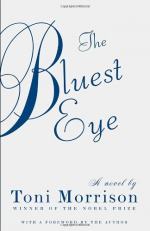|
This section contains 2,031 words (approx. 6 pages at 400 words per page) |

|
In the following excerpt, de Weever explores the crisis of black identity when cultural values are defined by a white society in Morrison's novel The Bluest Eye.
It used to be that black magazines like Ebony and Jet, barometers of the levels of black consciousness, carried advertisements for bleaching creams and hair-straighteners. Since the growth of black appreciation of natural color and texture and the advent of the slogan "Black is Beautiful," formed in protest to white standards of beauty, notices for bleaching creams no longer appear, although those for hair-straighteners still do. These illustrate the black woman's dilemma in a world where her white sisters are admonished: "Be a blond." "If you have one life to live, live it as a blond." Occasionally, one sees a black "blond" in the street or in the subway, vividly proclaiming the contradictions of her Identity and of her society...
|
This section contains 2,031 words (approx. 6 pages at 400 words per page) |

|




